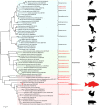Identification of a Novel Ichthyic Parvovirus in Marine Species in Hainan Island, China
- PMID: 31866980
- PMCID: PMC6907010
- DOI: 10.3389/fmicb.2019.02815
Identification of a Novel Ichthyic Parvovirus in Marine Species in Hainan Island, China
Abstract
Parvoviruses are a diverse group of viruses that are capable of infecting a wide range of animals. In this study, we report the discovery of a novel parvovirus, tilapia parvovirus HMU-HKU, in the fecal samples of crocodiles and intestines of tilapia in Hainan Province, China. The novel parvovirus was firstly identified from crocodiles fed with tilapia using next-generation sequencing (NGS). Screening studies revealed that the prevalence of the novel parvovirus in crocodile feces samples fed on tilapia (75-86%) was apparently higher than that in crocodiles fed with chicken (4%). Further studies revealed that the prevalence of the novel parvovirus in tilapia feces samples collected at four areas in Hainan Province was between 40 and 90%. Four stains of the novel parvovirus were identified in this study based on sequence analyses of NS1 and all the four strains were found in tilapia in contrast only two of them were detected in crocodile feces. The nearly full-length genome sequence of the tilapia parvovirus HMU-HKU-1 was determined and showed less than 45.50 and 40.38% amino acid identity with other members of Parvoviridae in NS1 and VP1 genes, respectively. Phylogenetic analysis based on the complete helicase domain amino acid sequences showed that the tilapia parvovirus HMU-HKU-1 formed a relatively independent branch in the newly proposed genus Chaphamaparvovirus in the subfamily Hamaparvovirinae according to the ICTV's most recent taxonomic criteria for Parvoviridae classification. Tilapia parvovirus HMU-HKU-1 likely represented a new species within the new genus Chaphamaparvovirus. The identification of tilapia parvovirus HMU-HKU provides further insight into the viral and genetic diversity of parvoviruses and its infections in tilapia populations need to be evaluated in terms of pathogenicity and production losses in tilapia farming.
Keywords: Chaphamaparvovirus; Parvoviridae; crocodile; novel virus; tilapia.
Copyright © 2019 Du, Wang, Chan, Wang, Huang, Yi, Zhu, Peng, Hu, Wu, Zeng, Zheng, Cui, Niu, Zhao, Lu, Yuen and Yin.
Figures


 ). The genera and subfamilies described in the newly proposed ICTV parvovirus taxonomic classification were highlighted in red.
). The genera and subfamilies described in the newly proposed ICTV parvovirus taxonomic classification were highlighted in red.
 ). The genera and subfamilies described in the newly proposed ICTV parvovirus taxonomic classification were highlighted in red.
). The genera and subfamilies described in the newly proposed ICTV parvovirus taxonomic classification were highlighted in red.
 ).
).References
LinkOut - more resources
Full Text Sources
Other Literature Sources

